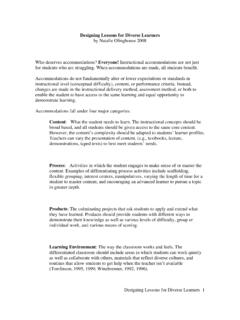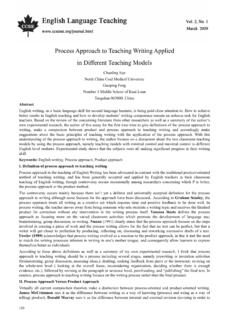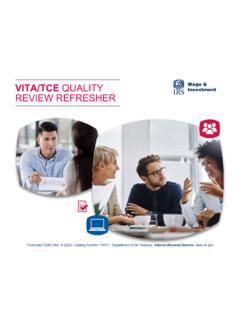Transcription of The Professional Portfolio: A Professional Development ...
1 The Professional Portfolio: A Professional Development Toolfor the Internship Michigan State UniversityTE 501 and TE 5022updated 8/3/07 What is a Professional portfolio ?A Professional portfolio is a collection of carefully selected artifacts that represent your progressand accomplishments in learning to teach. It is a Professional learning tool that you can use toreflect on your growth as a teacher over time, clarify your philosophy and teaching goals,connect those ideas to your emerging practice, and communicate your accomplishments toprospective employers. It is a place to demonstrate that your teaching practices lead tomeaningful student from prior interns indicates that although not all employers review portfolios, manygive prospective applicants an opportunity to refer to them during interviews. More importantly,many interns from previous years have reported that the experience of preparing a portfolio andthe effort involved in articulating and representing their talents, abilities, expertise andaccomplishments was an invaluable tool in preparing them for job interviews.
2 They felt moreconfident and prepared to talk about their philosophy, goals and experience after engaging in theportfolio Development process. Moreover, many states are encouraging beginning andexperienced teachers to develop Professional portfolios to promote ongoing professionallearning. Your portfolio can become a valuable tool to foster your ongoing learning throughoutyour ProcessesThe creation of a Professional portfolio is a Professional Development process through whichteachers document their progress and accomplishments in learning to teach for themselves, fortheir colleagues, and for prospective employers. Interns engage in several processes that assistthem in acquiring and making sense of new knowledge and skills and reflecting on their ongoingwork in the classroom:1 Reading: gathering evidence of new knowledge and information from texts, articles,teaching resources Writing: formal and informal writing that demonstrates thoughtfulness and integration ofnew knowledge Thinking: making new meaning, connecting ideas, taking stock, constructing newperspectivesWhile the above processes may take place individually, it is also important for teachers tointeract with colleagues to express their ideas, get feedback and learn from each , interns and their colleagues, in TE 501 and TE 502 seminars, in their TE 801-4courses, and in the Professional communities within their schools, also engage in: Interacting.
3 Sharing ideas, discussing and defending, actively constructing artifactsduring group inquiry 1 The categories for the portfolio process as represented in this document and the accompanying figure are adaptedfrom Wilcox, B. & Tomei, L. (1999). Professional Portfolios for Teachers: A Guide for Learners, Experts, andScholars. Norwood, MA: Christopher-Gordon 8/3/07 Demonstrating: presenting, critiquing, publishing, enhancing traditional lessons,applying thinking and learningAlthough the portfolio process necessarily cuts across all aspects of the internship experience,the portfolio assignment itself is officially connected to the TE 501 and TE 502 seminars, wherethe field instructors provide support and guidance and clarify During TE 501 & 502 SeminarsAlthough the portfolio necessarily cuts across all aspects of your internship experience, the tasksof engaging in portfolio processes and actually creating the physical portfolio itself are officiallyconnected to the TE 501/2 seminars.
4 Your field instructor will provide support and guidance,and clarify assignments. As outlined in the Mentoring Guide in the Guided to the Elementaryand Middle School Internship, your CTs are also asked to become involved in supporting yourportfolio processes as you engage in the seven phases of the internship (see Section 3: MentoringGuide).Drafting, Editing and Publishing the PortfolioIdentifying, Sharing, and Selecting Potential portfolio Artifacts: As you engage in reading,writing, thinking, interacting and demonstrating activities to enhance your Professional learningin the teacher preparation program, you will also gather and reflect upon various artifacts thatwill become potential portfolio items. In a sense, you are working on a "rough draft" of yourportfolio across your internship year, that you might think of as having two types of activities: Collecting: A major part of developing a teaching practice involves acquiring newknowledge and skills.
5 Artifacts that may represent your gathering of new knowledge andskills may include items such as: book notes textbook summaries journal articles trade books annotated bibliographies historical timelines curriculum overviews content standards lesson plans charts and graphs assessment tools posters videotapes world wide websites Working: By themselves, teaching resources do not demonstrate a teacher's professionalknowledge and skill. Attempts to create, test and hone your new knowledge and skill helpdocument how you are making connections, reflecting on and assessing your teachingpractice, and finding ways to learn with and from your colleagues. Artifacts that representthese aspects of your Professional learning may include:4updated 8/3/07 reactions to readings concept maps problem-solving strategies philosophy statement drafts self-evaluation of teaching feedback from colleagues on your teaching unit plans and reflections on teaching reflections on student learning videotapes of teaching sample assessments critiques of use of websites or electronicsoftware in the classroom group projectsInteracting and Demonstrating: Collecting and working with artifacts become especiallyhelpful when you take advantage of opportunities to share your ideas with colleagues.
6 Then youare able to articulate your thinking, reflect on your teaching decisions and actions, and learn fromyour ongoing practice. Your TE 501 and TE 502 seminars, as well as your TE 801-4 courses,are places where you will have opportunities to discuss many of the artifacts you may considerincluding in your portfolio . In addition, be sure to take advantage of your interactions withteacher colleagues in your school as you draft your CT is in a key position to help you identify and reflect on potential items that provideevidence of the heart of your work: engaging in standards-based teaching and meaningful studentlearning. Since your CT will be present and actively involved in collaborative unit teaching, s/hecan be especially helpful in advising you regarding what might count as evidence of effectiveteaching and meaningful learning ( , use of a particular assessment tool; samples of studentwork that represent their learning; observation notes from a classroom discussion).
7 These samediscussions have the potential to help the two of you reflect on whether and how the goals forunit teaching were met. Your CT can help you identify ahead of time what to collect, and toorganize yourself to collect information in feasible Drafting, Editing and Publishing of Your portfolio : Across your internship year, youwill have collected far more artifacts than you will be able to include in a portfolio that"showcases" your strengths and Professional accomplishments. You will need to select thoseitems that best represent and most effectively communicate your Professional learning to anaudience who is not familiar with the day-to-day details of your experience. The selectionprocess, therefore, includes: (a) choosing items as well as providing commentary (as needed)that help the audience make sense of how each artifact represents your learning andaccomplishments; and (b) making decisions about how to categorize, organize and present yourinformation.
8 CTs can be "interested readers" who provide valuable input in this final stage. Showcasing: Artifacts with commentary that represent your progress and accomplishmentsin learning to teach are included in the "final draft" of your Professional portfolio . Generally,these are artifacts that have been shared, critiqued and revised so that you can feel confidentthat they meet Professional standards to which you will be held. There are several differenttypes of artifacts that are needed to represent your expertise and talent as a learner andprofessional. The following items are examples of artifacts you may choose to include inyour Portfolio: 5updated 8/3/07 BackgroundInformationPresentations andBest PapersTeaching Artifactsand Reflections( with commentary)ProfessionalDocuments Resume www Homepage Backgroundinformation onteaching context Backgroundinformation onteacher preparationprogram Involvement inprofessionalorganizations Community servicerecord Philosophy Statementrelated to teaching forunderstanding andlearning communitydevelopment Personal Statementdescribing reasonsand motivations forchoosing the teachingprofession Goals Statementregarding immediateand future goals as aneducator Analysis ofcurriculum, teachingand/or studentlearning Outlines for formalpresentations Case studies ofstudent learning Representations ofyour use oftechnology ( ,computer generatedteaching materials)
9 Overview of unitgoals and instructionalplan that representteaching forunderstanding andlearning communitydevelopment List of resources used Sample lesson plans Assessment tools Evaluation of studentlearning Evidence of meetingindividual students'needs Photographs of classprojects or displays,discussions, bulletinboards Sample student work Reflectivecommentary, self-evaluation Feedback fromcolleagues onteaching Transcripts Letters ofRecommendation Letters ofAppreciation Awards, certificatesOrganizing the portfolio to Look ProfessionalWhile the above suggestions are listed in categories, only you can decide on the best way toorganize and present your artifacts to an outside audience. You should design your ownpresentation that: shows that you have met each Teacher Preparation Program Standard focuses on how your teaching has led to meaningful student learning is creative and original displays organizational skills provides a table of contents and/or overall organizer divides your materials into sections that are clearly labeled and easily understood communicates your key attributes, talents and values uses tools to enhance attractiveness (lettering, photographs, captions, charts, color,spacing/arrangement, borders, computer graphics, graphic organizers, variety ofmaterials) shows careful editing and proofreading6updated 8/3/07 Timeline for portfolio DevelopmentSeptember - December.
10 During this time period, you will engage in reading, writing, thinking,interacting and demonstrating that will contribute to your "collecting" and "working" withpotential artifacts for your portfolio processes begin in the fall months and continue on through the spring this involves collecting examples of classroom interactions, which you will share withothers (audio tapes, videotapes, still photographs), examples of students' work, or informationfrom short interviews with students, you will need to obtain formal parent/guardian permission todo so in accordance with your school and district policy. A sample cover letter, "Consent forDocumentation of Classroom Events and Student Work During the Internship" is included inAppendix C of the Guide to the Elementary Internship. The same letter is also available as aWord and RTF document on your Intern CD. You may use this example and adapt it to fit yoursituation, or write your own in consultation with your CT and building/district TE 501 seminar, you will share and discuss potential artifacts in order to reflect on yourprofessional learning and initiate ways to organize your materials.










